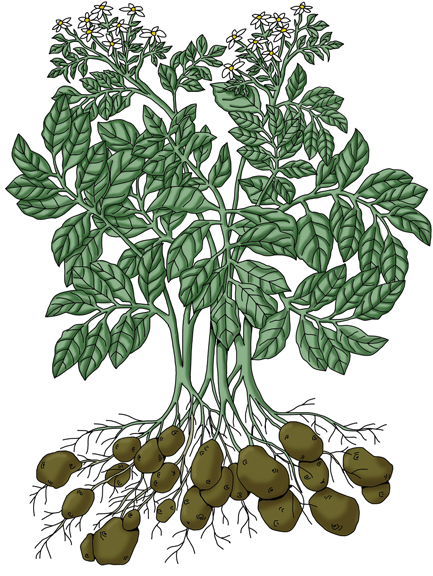


Potato Starts and Soil Prep: Potatoes are grown from small potato starts. They look like tiny potatoes. A little bit of soil preparation goes a long ways with potatoes. In the fall, dig up the beds that you are planning for next spring’s potato crop and mix them generously with manure. Potatoes do well in acidic soil.
Planting in Garden: Plant potato starts in about 4 inches of soil. They should be 20-30 inches apart on all sides, as they will be hilled up throughout the growing season as they grow taller and the potato crop expands. Potatoes love compost and loose soil. If you put a scoop of manure in the hole with the start when planted, they will be very happy. They also do well in deep beds where the soil is loose and aerated. This gives them room to grow a heavy crop of tubers. Don’t ever let the potatoes peek out of the soil, as exposure to the sun turns them green and inedible. If you run short of soil for hilling, use hay. Potatoes can actually be grown directly in hay with no soil at all. It also protects the potatoes from competing with weeds which will reduce yield.
Harvest: You can harvest early potatoes anytime after the plant flowers, however the longer you wait, the larger the tubers will grow. Be careful digging them up, as cutting through the skin of a potato makes it unsuitable for storage (eat those). Harvest the main crop on a dry day after the frost - but before a hard frost sets in. If the weather is dry, leave the potatoes to dry out and set up on top of the soil for 24-48 hours. If its rainy, you can set the potatoes on newspaper on the porch to dry out. Store them in a cold (50°), dark, dry root cellar. If you don’t have a root cellar, you can purchase a metal or plastic trash can, vent holes in the top and bottom and place it in a cold corner of the basement. Another alternative is to sink a new metal trash can into the ground and covered it with generous amounts of hay. It should stay at 50° all winter. In very cold places, a ring of styrofoam inside the lid will protect from freezing.
Pests and Disease: Potatoes are vulnerable to many ailments. Colorado potato beetles are relentless. They are bright yellow with black stripes and quickly visible when scanning plants. Approach carefully, as they will fly away or drop to the soil is startled. Grab them and squish them! They sometimes hide in the new bud leaves at the top of the potato plant, so push through those daily to find them and squish them. Once they appear, you must also check under all the potato leaves daily to scan for and squish their bright yellow eggs. If allowed to hatch, the fat, reddish larva will feed on the leaves and grow bigger and hungrier every day.
